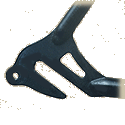The oval head badge on that Raleigh is the 1960s style. By 1970 they were using the heron cut out shape. It was Raleighs best seller for many years. The Gran(d) Prixs were made in many countries: Ireland, England, Canada and in the Raleigh owned Gazelle plant in the Netherlands. I assembled many hundreds of them, sold them and change out the crappy plastic simplex ders and just horrible ribbed tires. The tires were so squirmy, getting around a corner wasn't a sure thing. And yeah, the bb could have 28tpi threading or standard 24 depending on which factory it was made in.
I also assembled and sold Peugeots. Yours is not the bottom of the line, those had all steel parts with cottered cranksets. Like some companies, they did not put anything on the frame to tell which model it was. Just the brand ma'am. I bought 3 Peugeot uo8s mixtes for my sisters. French bikes were really popular with the ladies. I bought a Raleigh Gran Prix mixte for my mom. Mom is still riding it at age 85. Her Raleigh is now 40. Those 3 Peugeots all wound up in the scrapper over 25 years ago.
Rick






